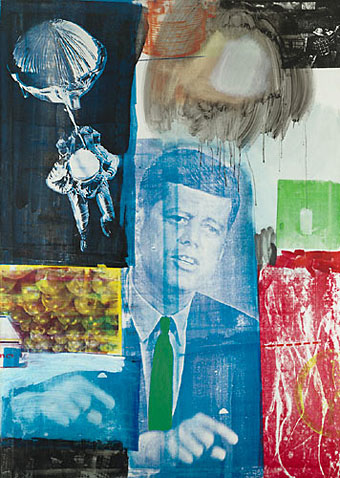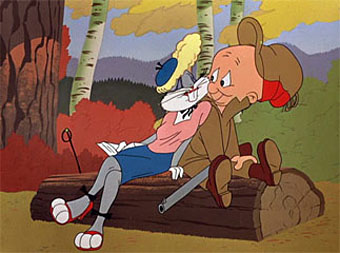Making us all imbeciles
| (UK) censors were once sent packing. But now they’re back.
Category: {television}
Television
Aubrey by John Selwyn Gilbert
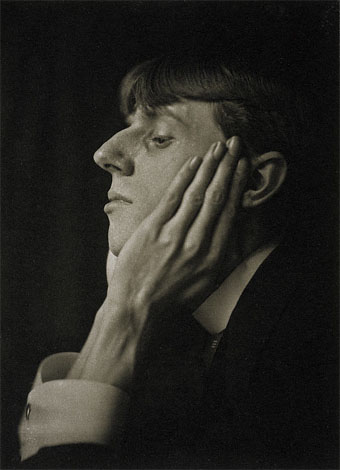
Aubrey Beardsley photographed by Frederick Evans (1894).
I’ve been going through the Coulthart VHS library recently, transferring to DVD recordings which can’t be purchased or found online. Among these is a drama from the BBC’s Playhouse strand, Aubrey by John Selwyn Gilbert, broadcast in 1982. This follows the life of artist Aubrey Beardsley from the time of Oscar Wilde’s arrest in April 1895—which event resulted in Beardsley losing his position at The Yellow Book—through the foundation of The Savoy magazine, to his tubercular death in March 1898.
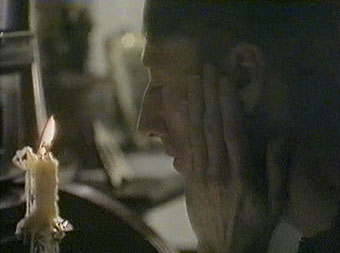
John Dicks as Aubrey.
Playhouse was a BBC 2 equivalent of Play for Today (which usually ran on BBC 1) and Aubrey like many other dramas of the period was shot on video in the studio. This was done for convenience as well as being cheaper than shooting on film, since scenes could be filmed using several cameras simultaneously. The drawback is that the image looks very harsh, and historical works such as this often seem unreal and artificial as a result. That aside, this was an excellent production with some great performances, especially Ronald Lacey as Leonard Smithers and Rula Lenska as Aubrey’s sister, Mabel. The details of Beardsley’s life are very accurate, down to his beloved Mantegna prints on the walls, and many of the scenes are arranged to correspond with his drawings, the production design being largely monochrome.
Robert Rauschenberg, 1925–2008
Retroactive I (1964).
My youthful enthusiasm for art acquainted me with the name of Robert Rauschenberg (who died two days ago) earlier than most. Surrealism and Pop Art held an appeal that was immediate, if rather superficially appreciated at the time, and it was seeing works from both those movements which were the most memorable aspect of my first visit to the Tate Gallery when I was 13. Later on when I was reading JG Ballard’s stories and essays in back numbers of New Worlds, Rauschenberg was one of a handful of artists who seemed to depict in visual terms what Ballard was describing in words. In this respect Robert Hughes’s discussion of the “landscape of media” (Ballard’s common phrase would be “media landscape”) below is coincidental but significant. Retroactive I was painted a couple of years before Ballard began the stories that would later become The Atrocity Exhibition and it could easily serve as an illustration for that book.
There are and will be plenty of words written elsewhere about Rauschenberg’s work and influence. I’ll note here his inclusion in the list of gay artists at GLBTQ for his creative and personal partnership with another great Pop artist, Jasper Johns.
One of the artists (television) most affected in the Sixties was Rauschenberg. In 1962, he began to apply printed images to canvas with silkscreen—the found image, not the found object, was incorporated into the work. “I was bombarded with TV sets and magazines,” he recalls, “by the refuse, by the excess of the world … I thought that if I could paint or make an honest work, it should incorporate all of these elements, which were and are a reality. Collage is a way of getting an additional piece of information that’s impersonal. I’ve always tried to work impersonally.” With access to anything printed, Rauschenberg could draw on an unlimited bank of images for his new paintings, and he set them together with a casual narrative style. In heightening the documentary flavour of his work, he strove to give canvas the accumulative flicker of a colour TV set. The bawling pressure of images—rocket, eagle, Kennedy, crowd, street sign, dancer, oranges, box, mosquito—creates an inventory of modern life, the lyrical outpourings of a mind jammed to satiation with the rapid, the quotidian, the real. In its peacock-hued, electron-sweetbox tints, this was an art that Marinetti and the Berlin Dadaists would have recognized at once: an agglomeration of memorable signs, capable of facing the breadth of the street. Their subject was glut.
Rauschenberg’s view of this landscape of media was both affectionate and ironic. He liked excavating whole histories within an image—histories of the media themselves. A perfect example is the red patch at the bottom right corner of Retroactive I. It is a silkscreen enlargement of a photo by Gjon Mili, which he found in Life magazine. Mili’s photograph was a carefully set-up parody, with the aid of a stroboscopic flash, of Duchamp’s Nude Descending a Staircase, 1912. Duchamp’s painting was in turn based on Marey‘s photos of a moving body. So the image goes back through seventy years of technological time, through allusion after allusion; and a further irony is that, in its Rauschenbergian form, it ends up looking precisely like the figures of Adam and Eve expelled from Eden in Masaccio’s fresco for the Carmine in Florence. This in turn converts the image of John Kennedy, who was dead by then and rapidly approaching apotheosis as the centre of a mawkish cult, into a sort of vengeful god with a pointing finger, so fulfilling the prophecy Edmond de Goncourt confided to his journal in 1861:
“The day will come when all the modern nations will adore a sort of American god, about whom much will have been written in the popular press; and images of this god will be set up in the churches, not as the imagination of each individual painter may fancy him, but fixed, once and for all, by photography. On that day civilization will have reached its peak, and there will be steam-propelled gondolas in Venice.”
Robert Hughes, The Shock of the New (1980).
Previously on { feuilleton }
• Transfer drawings by Robert Rauschenberg
• Jasper Johns
• Michael Petry’s flag
• JG Ballard book covers
Mouse Heaven by Kenneth Anger
Mouse Heaven: Minnie and Mickey.
Kenneth Anger’s paean to Disney rodent memorabilia, and one of his most recent works, turns up at the Grey Lodge. Mouse Heaven is a distinctly minor piece, an awkward mix of film and video which juxtaposes shots of mouse figurines with a song-based soundtrack. Scorpio Rising this isn’t but the editing is up to his usual standard, and it has a curious, if rather grotesque, charm.
Rabbit heaven: Bugs drags up again.
I suspect I’m not the ideal audience for a film such as this, never having been very taken with Mickey and the rest of the Disney crew. This seems to be a generational thing. My parents are about Anger’s age and they watched Disney shorts regularly at the cinema, while older Americans would have seen the Mickey Mouse Club on TV in the 1950s. By the time my sisters and I were watching cartoons on television Disney had retreated into the pop culture background. Plenty of merchandise was available, of course, but the animations that gave birth to these characters were rarely seen on British TV since Disney was worried about over-exposure of their precious assets.
The consequence of this (which I doubt they realised) was that a new generation of kids could happily and eagerly watch all the Warner Brothers Merry Melodies (and MGM’s Tom & Jerry and Tex Avery cartoons) whereas I’ve still seen very few Mickey Mouse cartoons. Those that did turn up were either primitive (Steamboat Willie) or presented a Mouse character that was actually a suburban middle-class American. The contrast between Donald Duck’s irritating petulance and Daffy’s wisecracks, or between the Mouse in a house and a bisexual rabbit, could hardly be more striking. The last shred of any potential Disney charm was dispelled when I read the priceless demolition of Disneyworld and its inhabitants, Mickey Rodent!, by Harvey Kurtzman and Will Elder, in a reprint of MAD magazine:
Strolling in the foreground of the opening panel is Mickey himself, with a four-day stubble on his face and a snapped mouse trap on his snout; his left arm has a TV screen, smashed in the middle, with “Howdy Dooit” sunrays visible. (That’s an inside joke: in a previous issue, parodying “Howdy Doody,” Mickey was seen at the edge of the opening panel, grasping and shouting, “That’s MY sunray from MY movies behind his head and I wannit back!”) Around him a melodrama unfolds: Horace Horszneck is being dragged off to jail “for appearing without his white gloves.” The animal chorus behind him clucks, moos and barks their annoyance with “Walt Dizzy’s” rule about wearing white gloves at all times… “In this hot weather too!” “And it’s so hard to buy those furshlugginer three-fingered kinds!” (Read the rest of the description here and try and see the comic for yourself; it’s a masterpiece.)
There was no going back after that, and Wally Wood’s Disneyland Memorial Orgy was merely the icing on an already mouldering cake. So, sorry Kenneth, but I’m an apostate; Bugs Bunny rules my blue heaven.
• The Look traces the history of Wally Wood’s scurrilous poster from hippie to punk to Alison Goldfrapp
Previously on { feuilleton }
• The Man We Want to Hang by Kenneth Anger
• Relighting the Magick Lantern
• The Realist
• Kenneth Anger on DVD…finally
Dirty Dalí
The paranoiac-critical gaze: Dirty Dalí.
I finally managed to see this fascinating documentary this week. Since my TV broke down some time ago I refused to waste money buying another, partly for the reason that films such as this are increasingly rare and most of them have been shunted to minority channel BBC 4 which I can’t receive. Thanks to BitTorrent you can still find the worthwhile stuff, of course, but this often requires patience.
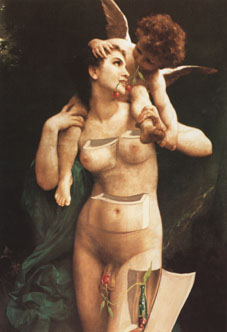
The Wines of Gala and of God (1977).
Dirty Dalí: A Private View was a reminiscence by art critic Brian Sewell about his encounters with Dalí and wife Gala at their home in Port Lligat in the late 60s and early 70s. What’s interesting about it is the first-hand light it throws on Dalí’s complicated sexuality, a subject which has been the source of speculation in biographies (notably Ian Gibson’s The Shameful Life of Salvador Dalí) but which is confused by the artist’s simultaneous revealing of his obsessions in his art and the veiling of his interests in public statements, not least the frequent declarations of impotence. Sewell confirms that Dalí was interested in both men and women although purely as a voyeur, and relates how his first encounter with the artist led to his having to lie naked in the armpit of a giant Christ sculpture in Dalí’s garden, masturbating while Dalí took photographs. Sewell also examines Dalí’s affair with Federico García Lorca, the closest the artist came to a gay romance, and his subsequent relationship with Gala, which became one where the pair used the artist’s celebrity to attract delectable people of both sexes, like a pair of art world super-swingers. According to Sewell, Dalí’s physical ideal was the hermaphrodite which would possibly explain his attraction to (alleged) transsexual Amanda Lear during this time.
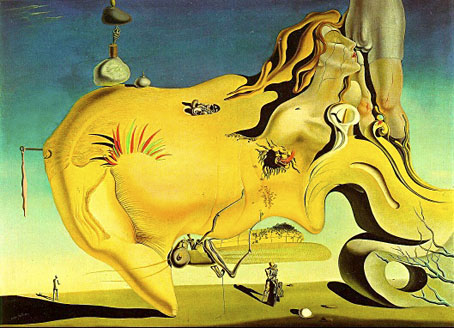
The Great Masturbator (1929).
As a piece of television the film struggles to fill out its running time by resorting to animating photographs, a persistent hazard for documentaries that lack the relevant raw material. All the footage of Dalí is lifted from previous documentary films including a large chunk of Russell Harty’s Aquarius interview, Hello Dali! (that camp double-entendre now seems very apt), from 1973. The overall effect of Sewell’s narrative is to add to Dalí’s already considerable feet of clay but that’s the inevitable outcome of nearly any biography; real lives are always messy. Sewell nonetheless ends by reaffirming Dalí’s principal importance as one of the great painters of the 20th century and, in an interesting side note, declares him to be the last great painter of a religious work with his Christ of St John of the Cross. A great religious artist and also one who produced hundreds of pornographic drawings, some of which are seen in the film. In art, as in the life, the contradictions are everywhere.
• Dirty Dalí at Grey Lodge
• Homage to Catalonia: Robert Hughes on Dalí
Previously on { feuilleton }
• Impressions de la Haute Mongolie revisited
• Dalí and Film
• Ballard on Dalí
• Fantastic art from Pan Books
• Penguin Surrealism
• The Surrealist Revolution
• The persistence of DNA
• Salvador Dalí’s apocalyptic happening
• The music of Igor Wakhévitch
• Dalí Atomicus
• Las Pozas and Edward James
• Impressions de la Haute Mongolie

